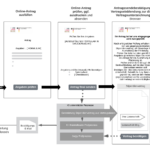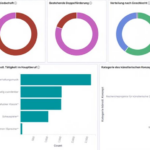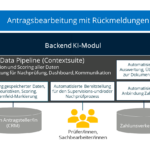In this project, we set up an intelligent application process in a very short time with easy-to-use online forms, intelligent, fast, secure and transparent digital processing that needs extremely few human resources.
Especially interesting is the fact that the same program has been implemented by another project team in a more conventional way with ten times more human resources, so that we can compare the results.
|
The project aimed at setting up and running an effective procedure for the funding programme NEUSTART (a governmental programme to support artists with stipends in the pandemic) in minimal time. The aim was to quickly help artists during the pandemic by allowing them to apply for funding for projects with minimal effort. The budget for funding for each project was 5000€, the total volume of funding was 30 million euros. Processing the thousands of artist applications had to be done in very short time with minimum personal capacity and yet be profoundly transparent, reliable and compliant.
Part One
The number of grant applications and other official requests, forms and alike, to be filled out by citizens and companies and to be processed by administrations has been growing year to year. Especially due to crises like the pandemic or energy crises, the federal government has set up more and more programmes to support citizens and companies. Dealing with application forms is annoying, time consuming and often not transparent for the applicants. For administrations, the set up and processing is extremely demanding, resource intensive and as a rule needs to be done in a very short timeframe. This in many cases results in badly designed, unreliable application processes, especially seen in many pandemic-era programmes.
This case is about one of the successful programmes for helping citizens – in this case German artists – through the pandemic by offering them funding for artistic projects.
Therefore the Secretary of State for Culture and Media (BKM) asked the main Collective Management Organisations (CMOs) in Germany to set up a compliant application process for the funding of artistic projects of their clientele. The programme, consisting of several sub-programmes, is called NEUSTART Kultur.
The BKM asked several collective rights management organisations like the Gema, the VG Wort, VG Bild, GVL and others to run the application process and distribute the funding.
There were mainly two different approaches chosen by the responsible organisations:
The timeframe was extremely short: the GVL only had a few weeks to set up an application process and start distributing almost 30 million of subsidies/funding to more than 5000 artists.
The GVL did not have enough human resources to service the demand, so it ordered external help by a consultant and a project manager.
Because of the limited temporal and human resources, and massive processing transactions, it was quite clear to us that the project needed smart automation and an end-to-end digital process.
Consequently, we planned to set up a smart, digitised process that needs minimum staff, can be run faster and more transparently. The budget for setting up and running the whole application process while also paying the staff needed was part of the programme funding provided by the government.

Part Two
The leading strategy was to set up an intelligent, end-to-end digitally supported application process within three months that needs minimum staff and would be reliable, compliant, effective and transparent.
The central part was first to set up a compliant process, then to implement a digital solution that best fit the process.
Because of the special requirements of this application programme, including a jury and a controlling instance (reporting), there was no fitting out-of-the-box solution on the market.
So we went looking for an IT solution provider who seemed capable of developing a new solution based on existing modules. We found the moresophy GmbH from Munich. The firm has a great deal of experience in data analysis of application processing and therefore developed the modular context suite.
The modules included an artificial intelligence semantic analysis machine, which was used to pre-analyse the contextual parts of the applications, i.e. the project descriptions, artistic references and – later on – the mandatory project reports.
In addition to the AI semantic analysis, we implemented formal analytics to check the application for fulfilling the formal requirements, such as income benchmark, certificates, health insurance and other official numbers.
The whole application process was digital from end to end. It started with the user frontend, where the application form, attachments plus the signature on the funding contract were 100% digital.
Due to governmental requirements the frontend had to be barrier-free, i.e. it had to be screen-reader compatible.
The chain proceeds with the formal and contextual analysis and processing of the application including the rating by the jury – a special task in itself.
The results of the automatic, formal and semantic analysis lead to an automatic first rating for each application: Applications with a rating reaching a defined threshold were directly forwarded to the jury for a final quality check. Applications with a lower rating, e.g. because of inconsistencies, noticeable problems or shortcomings were forwarded to one of the three staff members for a manual post-processing. This might have implied sending an e-mail to the applicant to forward missing information or documents.
Last but not least, we implemented an interface to the payment transaction connecting the organisation’s accounting system and set up the controlling and documentation of all transactions.
In the application process, the applicants were automatically informed by the system via email when a new stage or milestone had been reached.
The jury’s rating process was a task in itself, since it implied the following:
After analysing the first hundred applications, we found out that the applicants (artists) showed higher insecurities in filling out formal requirements than expected, e.g., a lot of artists apparently did not know what a “Einkommenssteuerbescheid” (income tax assessment) is and uploaded multiple types of documents but not the right one. Since income is a mandatory criteria for the funding of an artistic project, we implemented an automatic document recognition (based on image recognition) algorithm that filters the right from the wrong documents and automatically informs the application to replace incorrect uploads.
Because of the support needed by the artists and the extremely scarce resources, we contracted a call centre as a first level support instance.
Another problem was – as with most federal assistance programmes – coping with extremely high traffic in the beginning of the programme, so that we needed to scale the solution.
The implementation included technologies like:
Whereas the project management process had been done using agile and classic methods, like:

Part Three
In the end the whole project turned out to having achieved nearly all the goals:
There were only two counterpoints:
Altogether the project initiator and funder BKM acknowledged the achievement of the GVL in setting up the most effective funding process of all the organisations (CMOs) distributing funds. Furthermore, with the help of the smart digital analysis, we were able to filter several fraud attempts, another problem in many of such programmes.
Hopefully the project initiators on the government side will successively learn the implications of digitalisation projects. This would help to manage the projects more efficiently, with higher quality and lead to sustainable, mushrooming effects.
This shows how much more effective, user friendly, transparent and resource-sparing administration can be achieved through intelligent, continuous, digital processing.
The project shows clearly that it is possible to get better results – in less time with one tenth of staff!
Lastly but even more importantly, the digital solution can be adapted and applied to most application processing tasks especially in public administration.
Final note:The OZG is wrong focusing merely on the digital collection of data, we need to focus more on the processing to be more user friendly and resource sparing!
Let the machines do the jobs, they can do best and focus the human staff on the sensitive, informal analysis and rating.

Please ask the project manager Thomas Klauß via e-mail t.klauss@xpointo.de before contacting other people or the organisations involved in the project or before publishing the project information via other channels than this Knowledge Exchange : // Digitalisation database/platform.